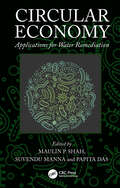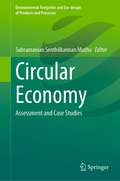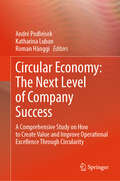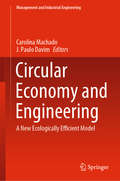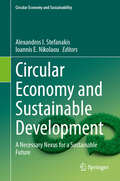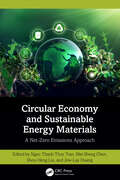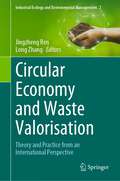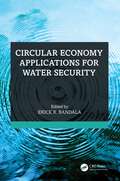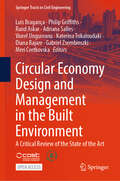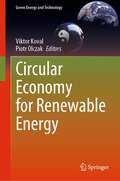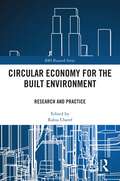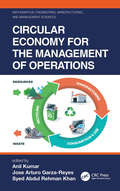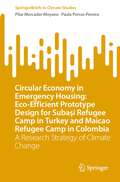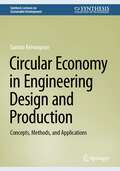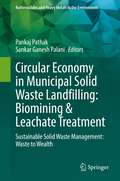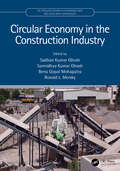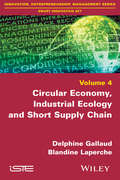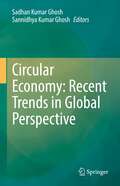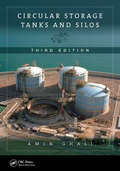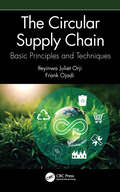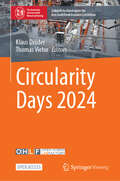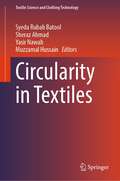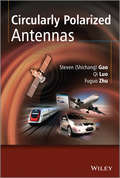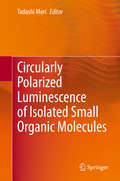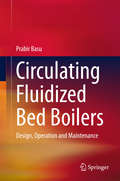- Table View
- List View
Circular Economy: Applications for Water Remediation
by Maulin P. Shah, Suvendu Manna, and Papita DasThe reclamation of wastewater (and other essential materials) is among the major research areas for understanding the effects of implementing a circular economic model. The re-use and re-cycling of wastewater can greatly reduce the overall demand for freshwater for various industrial applications. Such concepts could potentially greatly reduce the overall water demands of our planet if implemented successfully. Circular Economy: Applications for Water Remediation will examine the current understanding of the circular economy in water remediation processes, its drawbacks, and relatively unexplored areas that require further research. This book:• Provides an overview of the processes available to extract value-added materials from wastewater, such as clean water, nutrients, and energy.• Explores the possibilities of re-using wastewater for agricultural uses.• Provides an overview of the current policies and regulations concerning the implementation of circular economy concepts in wastewater remediation.
Circular Economy: Assessment and Case Studies (Environmental Footprints and Eco-design of Products and Processes)
by Subramanian Senthilkannan MuthuThis book highlights the notion of Circular Economy under the umbrella of Sustainability because of the widespread momentum it is gaining. Today the whole world is certainly in emergent need of an alternative system to traditional economy which is linear, i.e. make, use and dispose to get rid-off the waste and very important to ensure continuous use of resources, which is possible by the advent of circular economy. A circular economy aims to utilize the resources in use for as long as possible, extract the maximum value from them during use, then recover and regenerate products and materials at the end of each service life vis-à-vis traditional linear model. This book discusses circular economy in terms of assessment with various case studies.
Circular Economy: A Comprehensive Study on How to Create Value and Improve Operational Excellence Through Circularity
by André Podleisek Katharina Luban Roman HänggiWithout any doubt, the current prevailing Linear Economy principle of take-make-dispose is inherently unsustainable: Raw materials are extracted, transformed into products, and discarded as waste after use. The resulting environmental and economic challenges brought together both practitioners and academics to develop more sustainable methods for production and consumption. Especially the concept of Circular Economy has received a lot of attention. But despite many technical solutions, a key question for practical implementation has remained unanswered until now: How can enterprises integrate Circular Economy into their business strategy to leverage success? This book examines the topic of Circular Economy in an entrepreneurial context. It describes ten options for companies to retain value and identifies drivers and enablers for implementing Circular Economy in businesses. A survey among more than 500 industry experts revealed the extent to which retention options were implemented in practice. For the first time, relevant drivers and enablers for each retention option were identified. On top of this, case studies of successful circular market offerings shed light on each retention option in detail. The knowledge gained from research and the further shared experiences of experts that contributed to this book result in a 6-step management model. This model provides guidance on how to implement Circular Economy in organisations as an element of operational excellence and as a source of product, service, and business innovation. Now, every enterprise can start the journey. As the survey and the cases show: Circular Economy is a promising way to the next level of company success. The book at hand will help organisations to develop their own individual approach that matches their business model. In short, you will find: First comprehensive analysis of 10 retention options, their drivers, and enablers. Survey of more than 500 companies and in-depth case studies for each retention option. Practical research-based implementation model for companies.
Circular Economy and Engineering: A New Ecologically Efficient Model (Management and Industrial Engineering)
by Carolina Machado J. Paulo DavimThis book provides support to academics and researchers, as well as those operating in the management and engineering fields that need to deal with policies and strategies that allow to move towards a more sustainable paradigm, a greener economy that guarantees economic development and the improvement of living and working conditions. Drawing on the latest developments, ideas, research and best practice, this book examines the new advances in the subjects of circular economy.
Circular Economy and Sustainable Development: A Necessary Nexus for a Sustainable Future (Circular Economy and Sustainability)
by Alexandros I. Stefanakis Ioannis E. NikolaouThis book will highlight the role of CE in the sustainability field as it is expressed in the various fields and disciplines and its contribution to building a sustainable society by providing a better understanding of the relevant social and cultural structures and the need for cross-disciplinary knowledge and diverse skills. Such an integrated approach which combines the concept of sustainability in the engineering field to create a CE, has not yet been presented in detail in the published literature, and there are only scattered studies covering only small parts of this holistic approach. Hence, this book will represent a single reference that will provide summarized information and state-of-the-art knowledge on this topic of the future. The book will include chapters showcasing/investigating the relation between circular economy principles and their realization in different engineering fields. This includes theoretical justification, research studies and full-scale case studies. The approach focuses on two distinct levels: macro and micro, on both production and consumption sides.
Circular Economy and Sustainable Energy Materials: A Net-Zero Emissions Approach
by Ngoc Thanh Thuy Tran Jow-Lay Huang Wei-Sheng Chen Shou-Heng LiuAchieving carbon neutrality is crucial for creating a sustainable and resilient future worldwide. The circular economy framework focuses on reducing waste, optimizing resource use, and promoting regenerative practices, thus curbing carbon footprints. Concurrently, sustainable energy techniques, such as harnessing renewable sources, enhancing energy storage, and boosting energy efficiency, contribute to the reduction of greenhouse gas emissions. With a unique emphasis on net-zero emission approaches, this book delves into circular economy principles and sustainable energy materials, offering a comprehensive perspective on climate change challenges. Covers fundamental circular economy principles, from carbon capture to advancements in biomass and hydrogen energy Explores recycling techniques for essential energy materials, including batteries, solar cells, and fuel cells Provides detailed coverage of technologies, processes, and challenges related to achieving sustainability in the energy sector Bridges theory and practical applications Offering a roadmap toward a carbon neutral and net-zero emission future, this book serves as a valuable resource for advanced students, researchers, engineers, and policymakers worldwide seeking solutions to climate change and sustainable development.
Circular Economy and Waste Valorisation: Theory and Practice from an International Perspective (Industrial Ecology and Environmental Management #2)
by Jingzheng Ren Long ZhangThe authors and editors of this volume state that with the intensive growth of global industrialization and urbanization, the consumption of various resources and materials, such as energy, minerals, and even water, is increasing at an amazing speed, which poses great pressure on material resources. In addition, the massive utilization of materials has led to low efficiency, resulting in great wastes of resources as well as serious environmental pollutions and degradation, which has severely hindered the sustainable development of economy and society. In order to transit to sustainable development, it is necessary to improved resource efficiency, and circular economy and waste valorization are the best alternative ways for achieving this goal. This book aims to provide an in-depth description of circular economy and waste valorization, make assessments for circular economy and waste valorization in different regions and countries and determine the technological pathways and roadmap for achieving circular economy and waste valorization. More specifically: (1) Conceptions and Theories: Concepts and definitions of circular economy and waste valorization and their nexus and contributions to sustainable development. (2) Policy and Practice: Measurement and assessment of performance or sustainability for implementing circular economy and waste valorization. (3) Pathways and Prospects: Identification and prioritization of the barriers, strategies, technologies, and pathways for achieving circular economy and waste valorization. The book systematically and comprehensively introduces the definitions, concepts, framework and nexus of circular economy and waste valorization, analyzes and measures their performance and sustainability and provides the methods for investigating and prioritizing the barriers and strategies and determining the pathways and roadmap for their development.
Circular Economy Applications for Water Security
by Erick R. BandalaIn arid and semi-arid regions, where water demand exceeds water availability, water security is becoming a significant concern not only related to water availability but also to rigorous and costly requirements to remove conventional and emerging contaminants from effluents discharging into drinking water sources or as water reuse becomes an alternate water supply for communities in these regions. Water and wastewater treatment demands a great amount of energy and resources, highlighting the need for novel applications of the circular economy concept. Circular Economy Applications for Water Security examines knowledge gaps, avenues of future research, and challenges related to the potential of enhanced underutilized/waste materials as a transition to circular economy applications for ensuring the proper quality of water. This book includes fundamental information and practical examples that helps to better understand the concepts included. The circular economy concept is helpful to incept sustainability in the water treatment processes. Every chapter includes the identification of knowledge gaps, avenues for further research, and challenges that guide readers towards real state-of-the-art analysis. Contributors are experts in their areas and will commit to explaining concepts in a user-friendly way without missing scientific rigor.
Circular Economy Design and Management in the Built Environment: A Critical Review of the State of the Art (Springer Tracts in Civil Engineering)
by Luís Bragança Philip Griffiths Rand Askar Adriana Salles Viorel Ungureanu Katerina Tsikaloudaki Diana Bajare Gabriel Zsembinszki Meri CvetkovskaThis open access book offers a comprehensive exploration of Circular Economy Design and Management within the Built Environment, presenting a critical review of the current state of the art. Going through multi-level approaches from material usage to urban planning, it meticulously examines strategies for circular building design, criteria, and indicators for circularity. Additionally, it explores practical tools and frameworks, as well as roles and relationships of stakeholders along the entire value chain. Through insightful case studies and critical analysis, readers gain a deep understanding of circularity principles and applications, circularity management models and feedback systems, sustainable practices, and the integration of circularity into technological advancements and digital tools such as BIM. The importance of this book lies in addressing pressing challenges in contemporary architecture and construction, providing a roadmap for sustainable, circular solutions. It tackles the critical need to transition from linear to circular practices, emphasising resource efficiency, waste reduction, and the longevity of structures. By offering practical insights and highlighting successful implementations, the book aims to guide architects, civil engineers, designers, sustainability professionals, and policymakers towards informed decision-making in creating environmentally conscious built environments. Designed for these professionals and researchers, this book serves as a valuable resource for anyone passionate about reshaping the future of our built spaces with a focus on circularity and environmental responsibility.
Circular Economy for Renewable Energy (Green Energy and Technology)
by Viktor Koval Piotr OlczakThis book explores the role of renewable energy sources in driving sustainable development, with a focus on their circular use in achieving environmental efficiency and an energy balance. The authors highlights the significance of renewable energy in reducing costs for producers and consumers while also ensuring the production of clean energy that can be integrated seamlessly into the national power grid without compromising reliability or energy security.Readers are introduced to the circular economy model and its importance in the context of renewable energy. The book sheds light on the challenges associated with transitioning to alternative energy systems, particularly in cases where not all resources can be fully circulated. Through the research presented in this book, stakeholders will gain insights into how the sustainable renewable energy supply chain can be adapted within the circular economy. This will have a synergistic effect in reducing carbon emissions, and also aid in the production of renewable energy equipment.
Circular Economy for the Built Environment: Research and Practice (ISSN)
by Rabia CharefThis book provides an overview of the circular economy in the built environment, presenting a fusion of insights from esteemed researchers and seasoned practitioners. The chapters cover pivotal themes, including the transformative concept of buildings as material banks, innovative design approaches, and the potential of digitalization for a circular built environment. Beyond these foundational themes, the book critically addresses the integration of low-tech solutions and some principles of sobriety in the built environment. It also takes an informed look at the role of standardization, providing nuanced insights into its driving influence on circular practices and the associated challenges and opportunities.The book adopts a trans-scalar perspective by traversing the entire spectrum of building phases from initial programming to the recovery phase, as well as from the scale of materials to the scale of buildings, offering a profound examination of the intricate dynamics involved in the offer/demand for recovered materials. This book highlights the paramount need to harmonize research with practical applications. By spotlighting effective circular practices and elucidating the challenges faced by practitioners, it identifies fertile grounds for further research. Moreover, the book extends its reach by offering practical ideas on how practitioners can seamlessly adopt a circular approach in both thought and realization.Circular Economy for the Built Environment: Research and Practice is a must-read book for students, researchers, academics, and practitioners in the fields of architecture, planning, engineering, construction, and real estate. This book provides a compelling narrative that bridges the theoretical and practical realms of the circular economy in the built environment.
Circular Economy for the Management of Operations (Mathematical Engineering, Manufacturing, and Management Sciences)
by Anil Kumar Syed Abdul Rehman Khan Jose Arturo Garza-ReyesCircular-Economy is a new concept in operations management. Its goal is to redefine growth, focusing on positive benefits arising for society as a whole out of efficiencies such as designing waste out the operations process. This book will help practitioners use the proper strategy for effective adoption of Circular practices to use in their organization. Features: Provides a complete understanding of Circular-Economy practices Offers advanced mathematical models to help industry management adopt the correct practices Presents a deep understanding of cross-functional and customer-focused design thinking Covers how to develop sustainable practices in all types of activities within operations management. Circular Economy for the Management of Operations will be of interest to practitioners and researchers in engineering as well as business management
Circular Economy in Emergency Housing: A Research Strategy of Climate Change (SpringerBriefs in Climate Studies)
by Pilar Mercader-Moyano Paula Porras-PereiraIn recent years, there has been an upsurge in the number of forced displacements due to natural disasters, armed conflicts, and pandemics, which has favoured an increase in the number of temporary accommodations. Although the provision of shelter after an emergency situation is one of the priorities of humanitarian aid, the reality is that the conditions in which people live in a situation of forced displacement are absolutely precarious and overcrowded. Nowadays, this type of housing tends to have a short lifespan, deepening the environmental impact and the generation of waste. Likewise, added to this great problem is the linear economic system implemented worldwide, which also causes a high rate of waste.This investigation develops an eco-efficient design protocol that determines the basic premises in any emergency situation, therefore avoiding the precarious nature to which those in forced displacement are exposed. Moreover, the research investigates different constructive solutions that can respond to situations of natural catastrophes or humanitarian disasters where emergency housing is needed as well as the possible alternatives from the point of view of circular economy. Eco-efficient and environmentally correct solutions are sought, which can be adaptable to the different scenarios where emergency housing may be needed, thus creating a rapid, easy, functional, and environmentally correct architecture, adaptable to these types of situations. The study shows that the factors that characterize emergency architecture can be an example of where the issues around the sustainability factor are applied in a practical way. The main objectives of this study are to develop an eco-efficient design protocol which determines the basic premises in any emergency situation and to find eco-efficient and environmentally correct solutions, adaptable to different scenarios, which have similar climatic characteristics, and where emergency housing may be needed, thus creating a type of ephemeral architecture but sensitive to the user to whom it is intended and in accordance with the optimal conditions of habitability.
Circular Economy in Engineering Design and Production: Concepts, Methods, and Applications (Synthesis Lectures on Sustainable Development)
by Samira KeivanpourThis concise text provides the concepts, methods, and application examples for integrating sustainability into engineering design and production. It discusses the role of sustainability in the value creation processes of various enterprises and different tools and methods for systematic incorporation of social and environmental aspects into the product's life cycle. The following topics are covered: sustainable development in engineering systems and the life cycle concept, norms and standards in the sustainable development and integration of socio-economic assessment into technical valuation, production systems, management of the production systems based on circular economy principles, ecodesign practices, and value creation and innovative design in the circular economy. Provides a concise guide for engineering students for applying circular economy practicesPresents examples and short case studies for understanding the methods and toolsFacilitates understanding and application of the life cycle perspective in product manufacturing and green engineering
Circular Economy in Municipal Solid Waste Landfilling: Sustainable Solid Waste Management: Waste to Wealth (Radionuclides and Heavy Metals in the Environment)
by Pankaj Pathak Sankar Ganesh PalaniThis book will serve as a ready reckoner of contemporary information regarding municipal solid waste landfill biomining, treatment of landfill leachate and heavy metals in a single platform. The academicians, researchers, and students at master’s and doctoral levels will be able to understand the current trends in municipal solid waste landfill operations, which will help in augmenting their research. Construction of new landfills requires huge monetary investments, which can be avoided if old landfills were bio-mined for resources and the space can be re-used as new landfills. Landfill leachate is a hazardous waste which needs proper treatment that could generate value-added products such as clean energy and biofertilizers. In this book, each chapter would provide the background, methodology, and relevant calculations for sustaining landfill operations. Also, the case studies based on best practices in municipal solid waste landfilling are discussed in this book.
Circular Economy in the Construction Industry (The Circular Economy in Sustainable Solid and Liquid Waste Management)
by Sadhan Kumar Ghosh Sannidhya Kumar Ghosh Benu Gopal Mohapatra Ronald L. MerskyCircular Economy in the Construction Industry is an invaluable resource for researchers, policymakers, implementers and PhD and Masters-level students in universities analyzing the present status of Construction and Demolition Wastes (C&DW) management, materials development utilizing slag, fly ash, HDPE fibre, geo-wastes, and other wastes, green concrete, soil stabilization, resource circulation in construction sectors, success in experimentation & commercial production, future needs, and future research areas. While huge C&DW is wasted by dumping, there is potential of recycling preventing greenhouse gas (GHG) emissions and environmental pollution as well as creating business opportunities. Circularity of resources in the construction industry can contribute to a more secure, sustainable, and economically sound future through proper policy instruments, management systems, and recycling by selecting the following: Supply chain sustainability and collection of C&D Wastes, Appropriate separation and recycling technology, Enforcement of policy instruments, Productivity, quality control of recycled products and intended end use, Economic feasibility as business case, commercialization, generating employment. This book addresses most of the above issues in a lucid manner by experts in the field from different countries, which are helpful for the related stakeholders, edited by experts in the field.
Circular Economy, Industrial Ecology and Short Supply Chain: Towards Sustainable Territories
by Blandine Laperche Delphine GallaudIn contrast to the linear "take-make-dispose" model of resource consumption, a new industrial model is proposed in the form of a circular economy. This model aims to optimize the use of resources and to reduce or eliminate waste, and is based on re-use, repair, ecodesign, industrial ecology, sustainable supply and responsible consumption. Industrial ecology and short supply chains can contribute - particularly on a territorial scale - to the emergence of a real sustainable development. This book develops these concepts and presents experiments that are taking place in France and other countries, in addition to an integrated model which details the mechanisms through which industrial ecology and short supply chains can generate economic, social and environmental profits. The possible issues and obstacles facing these new practices are also analyzed, in order to develop the outline of an adapted management and governance which will enable them to be fully realized.
Circular Economy: Recent Trends in Global Perspective
by Sadhan Kumar Ghosh Sannidhya Kumar GhoshThis book presents the advantages of the circular economy as a powerful - and inevitable - model for tackling the current challenges against shrinking resources and establishing the resource efficient economy. The experienced contributors present the status and strategies of circular economy implementation in several countries with hands on experience to protect the environment while promoting the circular economy through legislative requirements, best practices adopted and popularizing the idea of circulation of resources amongst the researchers & academia, policy makers, industry, and the general public at large. The book advocates model that consists of designing products and processes with a view to endlessly recycling them evolving a greater scope of sustainable development.
Circular Storage Tanks and Silos
by Amin GhaliThis book presents practical methods for the analysis and design of circular concrete tanks. The methods can also be used for silos, pipes, or any circular shells subjected to arbitrary axially symmetrical loading, and also deal with the more general problem of beam on elastic foundation. The book includes a new chapter on the design of construction of circular tanks, comes with new easy-to-use computer programs, and provides design examples that include post-tensioned concrete walls, footings, floors and roofs, and liquid-tight connections between these components.
The Circular Supply Chain: Basic Principles and Techniques
by Ifeyinwa Juliet Orji Frank OjadiOrganizations need to stay competitive and transition from a linear make-use-dispose supply chain model to a sustainable one. This book covers techniques and basic principles, historical developments and recent issues facing the adoption of a circular supply chain model. The Circular Supply Chain: Basic Principles and Techniques presents the key principles and techniques for the effective integration of a circular economy into supply chains. It discusses sustainability, digitization and the application of blockchain to enhance operations within the realm of Industry 4.0. Principles to assist managers in effectively adopting circularity business models for sustainability improvements are provided, along with the historical background, so the reader can have a better understanding for implementation. Case studies and reading comprehension questions are also offered to help with the effective integration of a circular economy into supply chains. This book is written to assist students, practicing engineers and business professionals that work in the industrial and manufacturing sectors, supply chain management, and with advanced technologies associated with Industry 4.0, sustainability, blockchain and digitalization integration techniques of circular supply chains.
Circularity Days 2024 (Zukunftstechnologien für den multifunktionalen Leichtbau)
by Klaus Dröder Thomas VietorThis book comprises the proceedings of the conference “Circularity Days 2024”, which took place from May 15th-16th in Wolfsburg. The conference focused on key topics such as Design for Remanufacturing, Circular Production, and Sustainable Materials and Applications. The emphasis was placed on products that are easily disassembled, repaired, and remanufactured, utilizing innovative manufacturing methods to minimize resource consumption, energy usage, and emissions, and highlighting eco-friendly materials and their role in achieving circularity. Especially circular production methods, which combine the advantages of minimal resource consumption and maximal reusability, have a high potential for reducing the environmental impact, while simultaneously extending the product lifecycle. The future, efficient and scalable integration of sustainable materials and circular production methods requires innovations and constant developments in design and manufacturing technology. This is an open access book.
Circularity in Textiles (Textile Science and Clothing Technology)
by Syeda Rubab Batool Sheraz Ahmad Yasir Nawab Muzzamal HussainThis book explains the basic principles of recycling and circularity in textiles. With the emergence of "quick fashion," textile manufacturing has expanded significantly over the past few decades. The importance of textiles to human society goes beyond their practical uses in providing warmth, protection, and comfort. Therefore, the usage and production of textiles are enhanced substantially compared to the past globally. As a result, rates of textile production and trash output have grown drastically. The other side of the story is the drastic rate at which they are dumped into landfills which is almost a garbage truck every second. If this alarming trend continues, there will be serious environmental consequences. It is well known that the textile sector is recognized as the second largest industrial polluter in the world, producing 20% of the global wastewater and accounting for 10% of carbon emissions. Additionally, harmful chemicals are utilized and emitted during the manufacture of textiles, which has an impact on ecosystems and public health The last 150 years of the textile industrial system fundamentally follow the "take-make-dispose" principle, in which resources are continuously taken out of a natural system (take), changed during production (make), and used for various purposes within the human system (use), and then released back into the environment (dispose of). In this way, manufacturing industries produce waste-producing commodities to make money, which eventually has a negative impact leading to the lack of resources resulting in price volatility, uncertainty, and economic crises. This book consists of 11 potential chapters to cover all the aspects of “circularity in textiles.”
Circularly Polarized Antennas (Wiley - IEEE)
by Steven Shichang Gao Qi Luo Fuguo ZhuThis book presents a comprehensive insight into the design techniques for different types of CP antenna elements and arrays In this book, the authors address a broad range of topics on circularly polarized (CP) antennas. Firstly, it introduces to the reader basic principles, design techniques and characteristics of various types of CP antennas, such as CP patch antennas, CP helix antennas, quadrifilar helix antennas (QHA), printed quadrifilar helix antennas (PQHA), spiral antenna, CP slot antennas, CP dielectric resonator antennas, loop antennas, crossed dipoles, monopoles and CP horns. Advanced designs such as small-size CP antennas, broadband, wideband and ultra-wideband CP antennas are also discussed, as well as multi-band CP antennas and dual CP antennas. The design and analysis of different types of CP array antennas such as broadband CP patch arrays, dual-band CP arrays, CP printed slot arrays, single-band and multi-band CP reflectarrays, high-gain CP waveguide slot antennas, CP dielectric resonator antenna arrays, CP active arrays, millimetre-waveband CP arrays in LTCC, and CP arrays with electronically beam-switching or beam-steering capabilities are described in detail. Case studies are provided to illustrate the design and implementation of CP antennas in practical scenarios such as dual-band Global Navigation Satellite Systems (GNSS) receivers, satellite communication mobile terminals at the S-band, Radio Frequency Identification (RFID) readers at 2.4 GHz, and Ka-band high-speed satellite communication applications. It also includes the detailed designs for a wideband Logarithmic spiral antenna that can operate from 3.4-7.7 GHz. In addition, the book offers a detailed review of the recent developments of different types of CP antennas and arrays. Presents comprehensive discussions of design techniques for different types of CP antennas: small-size CP antennas, broadband CP antennas, multi-band CP antennas and CP arrays. Covers a wide range of antenna technologies such as microstrip antennas, helix, quadrifilar helix antenna, printed quadrifilar helix antenna, dielectric resonator antennas, printed slots, spiral antennas, monopoles, waveguide slot arrays, reflectarrays, active arrays, millimetre-wave arrays in LTCC, electronically beam-switching arrays and electronically beam-steerable arrays. Reviews recent developments in different types of CP antennas and arrays, reported by industries, researchers and academics worldwide. Includes numerous case studies to demonstrate how to design and implement different CP antennas in practical scenarios. Provides both an introduction for students in the field and an in-depth reference for antenna/RF engineers who work on the development of CP antennas. Circularly Polarized Antennas will be an invaluable guide for researchers in R&D organizations; system engineers (antenna, telecom, space and satellite); postgraduates studying the subjects of antenna and propagation, electromagnetics, RF/microwave/millimetre-wave systems, satellite communications and so on; technical managers and professionals in the areas of antennas and propagation.
Circularly Polarized Luminescence of Isolated Small Organic Molecules
by Tadashi MoriThis book collects all the latest advances in the leading research of the circularly polarized luminescence (CPL) of small organic molecules. Compared with that of lanthanide-based fluorophores, the research into the CPL of small organic molecules is still at the developmental stage for their relatively smaller dissymmetric factors, but has been a source of widespread attention recently. The book includes the state of the art of the discoveries in CPL organic molecules, such as helicenes, biaryls, cyclophanes, boron dipyrromethene dyes, and other chiral molecules, mostly in their isolated states, covering all possible chiral substances for future applications. This book also highlights the recent development of CPL instruments as well as time-resolved circular dichroism spectroscopy, to facilitate the further development and future design of CPL molecules.
Circulating Fluidized Bed Boilers: Design, Operation and Maintenance
by Prabir Basu· Explains operation and scientific fundamentals of circulating fluidized bed (CFB) boilers · Outlines practical issues in industrial use · Teaches how to optimize design for maximum reliability and efficiency · Discusses operating and maintenance issues and how to troubleshoot them This book provides practicing engineers and students with insight into the design and operation of circulating fluidized bed (CFB) boilers through a combination of theoretical concepts and practical experience. An emphasis on combustion, hydrodynamics, heat transfer, and material issues illustrates these concepts with numerous examples from actual operating plants. The relevance of design and feed-stock parameters to the operation of a CFB boiler are also examined, along with their impacts on designs of mechanical components, including cyclones, air distributor grids, and solid recycle systems. This versatile resource explains how fluidized bed equipment works and how the basic principles of thermodynamics and fluid mechanics influence design, while providing insight into planning new projects, troubleshooting existing equipment, and appreciating the capabilities and limitations of the process. From hydrodynamics to construction and maintenance, the author covers all of the essential information needed to understand, design, operate, and maintain a complete fluidized bed system. It is a must for clean coal technology as well as for biomass power generation.
